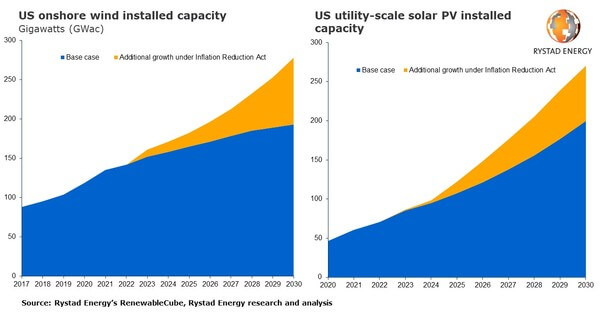News Release from Rystad Energy
Wind Industry Profile of
Inflation Reduction Act will attract an extra $270 billion in US wind and solar investments by 2030
The projects added due to the new incentives are expected to attract additional investments of more than $270 billion in the next eight years as developers take advantage of the beefed-up tax credits.
To put it into perspective: The US is on track to have 140 GW of onshore wind capacity installed by the end of this year. Under the previous credits, this was expected to rise to 193 GW by 2030. The new law is likely to trigger another 85 GW, pushing total onshore wind capacity close to 280 GW by the end of the decade. These new wind developments will result in an additional $160 billion of investments.
Utility-scale solar installations – large-scale solar farms, excluding residential capacity – are set to get a boost of about 70 GW by 2030 due to the new incentives, with a projected capacity topping 270 GW in 2030. This extra solar capacity will deliver about $110 billion of capital expenditure. The act's impact on the solar industry will be significant – but it will not be immediate. The sector is still dealing with lingering effects from the anti-dumping and countervailing investigation into southeast Asian panel imports, a ban on polysilicon from the Chinese province of Xinjiang, and backlogged interconnection queues. As such, the full effect of the new incentives will not be realized until around 2024.
“The Inflation Reduction Act is a game changer for the US wind and solar industry. The tax credits in the bill will strengthen the economic feasibility of new project developments and boost the wind and solar markets’ growth trend this decade and beyond. In particular, onshore wind capacity growth, which was expected to slow towards 2030, is now expected to regain momentum towards the end of the decade,” says Rystad Energy renewables analyst Marcelo Ortega.

Learn more with Rystad Energy’s RenewableCube (Image: Rystad Energy)
The Inflation Reduction Act has been a long time coming. Even though the final version is significantly pared down from the first drafts, the law will have wide-ranging implications for low-carbon energy developments. In addition to wind and solar, the bill will boost the outlook for the nuclear, hydrogen, carbon capture and storage and geothermal sectors and accelerate electric vehicle adoption. There will also be a lift for battery storage, a critical component in the electrification of the power grid due to the intermittent nature of some renewable energy sources.
Offshore wind developments are also incentivized under the law, including measures that are intended to lessen the impact of existing supply chain bottlenecks. However, these challenges – mainly the limited supply of wind turbine installation vessels – will persist and as a result, the new tax credits are unlikely to encourage significant capacity growth beyond existing forecasts until the 2030s.
The incentives expand existing tax credits for capital investments and production, and are designed to build and strengthen a domestic supply chain by encouraging domestic manufacturing and raw material sourcing from the US or countries with a free trade agreement.
The current production tax credit (PTC) of $0.15 per kilowatt-hour and the investment tax credit (ITC) of 30% will continue until 2024, after which they will roll into one technology-agnostic clean energy ITC or PTC. The law will enact base rates of $0.3/kWh for the PTC and 6% for the ITC. Developers can benefit from a five-times credit multiplier if specific labor qualifications are met, and additional benefits are up for grabs for those that meet domestic content requirements for steel, iron and equipment, and siting conditions. Rystad Energy has assumed that all developers will opt for the initial five-times multiplier, raising the PTC to $0.15/kWh, subject to inflation at 2.5%, and the ITC will be raised to 30%.
The internal rate of return (IRR) – a metric used to evaluate the profitability of project investments – will increase by one or two percentage points for solar and wind projects. The new legislation will also make the PTC available for solar projects, which were previously unable to take advantage of this tax credit. Developers may opt for the PTC as solar costs have dropped significantly over the past decade. Despite current global supply hiccups, solar will continue to have one of the lowest levelized cost of electricity among energy technologies.
When evaluating the bill’s impact on the net present value of projects, developers will for the first time have multiple incentive options to choose from. We estimate that for a 250-megawatt (MW) utility-scale solar project, the PTC will be the most beneficial tax credit until a 7.5% discount rate is achieved, after which the ITC will be the preferred tax credit. Meanwhile, the PTC will remain the best option for utility wind developers, as it was before the bill.
For more analysis, insights and reports, clients and non-clients can apply for access to Rystad Energy’s Free Solutions and get a taste of our data and analytics universe.
- Source:
- Rystad Energy
- Author:
- Press Office
- Link:
- www.rystadenergy.com/...
- Keywords:
- Rystad Energy, USA, Inflation Reduction Act, investments, industry, solar, wind, offshore, onshore, Joe Biden, decade, energy security, GW, capacity


























